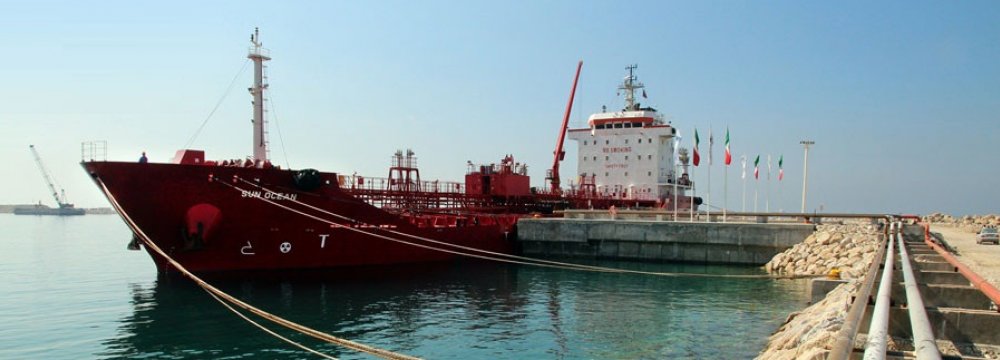
Rise in South Pars Condensate Exports

According to the head of customs at Pars Special Economic Energy Zone, over 1.28 million tons of gas condensates, worth about $504 million, were exported between Oct. 23-Nov. 21, IRNA reported on Sunday.
Ahmad Pourheidar added that gas condensate export shows a 4% rise in terms of both volume and value compared with the similar period of last year.
Iran produced close to 115 million barrels of condensates, or nearly 530,000 barrels a day, in the first seven months of the present fiscal (March 21-Oct. 22).
Condensate output is slated to reach 1 million barrels a day upon the launch of all phases of South Pars—the giant gas field shared by Iran and Qatar. But Tehran has said it wants to reduce the outbound shipments of condensates and instead use the fossil fuel for manufacturing goods with higher value added.
The official also said over 2.53 million tons of petroleum commodities, including methanol, propane, polyethylene, sulfur, urea, styrene and ammonia, were exported in that month, generating $1.1 billion. That shows a 2% rise in tonnage and 18% rise in value.
On the main destinations of Iranian exports, he said the commodities are mostly sent to Asian countries like China, Japan, South Korea, India, Indonesia, Turkey, the UAE and Kuwait as well as Egypt in Africa.
Pourheidar noted that more than 16,000 tons of goods worth about $128 million, including refinery equipment and raw materials, were imported in the same period for use in South Pars petrochemical complexes.
South Pars is the world's largest gas field shared between Iran and Qatar in the Persian Gulf. The giant deposit, which is being developed in 24 phases, provides about two-thirds of Iran's natural gas output.
The field holds an estimated 51 trillion cubic meters of gas and some 50 billion barrels of gas condensate.


Trump weighs using $2 billion in CHIPS Act funding for critical minerals

Codelco cuts 2025 copper forecast after El Teniente mine collapse

Electra converts debt, launches $30M raise to jumpstart stalled cobalt refinery

Barrick’s Reko Diq in line for $410M ADB backing

Abcourt readies Sleeping Giant mill to pour first gold since 2014

Nevada army depot to serve as base for first US strategic minerals stockpile

SQM boosts lithium supply plans as prices flick higher

Viridis unveils 200Mt initial reserve for Brazil rare earth project

Tailings could meet much of US critical mineral demand – study

Kyrgyzstan kicks off underground gold mining at Kumtor

Kyrgyzstan kicks off underground gold mining at Kumtor

KoBold Metals granted lithium exploration rights in Congo

Freeport Indonesia to wrap up Gresik plant repairs by early September

Energy Fuels soars on Vulcan Elements partnership

Northern Dynasty sticks to proposal in battle to lift Pebble mine veto

Giustra-backed mining firm teams up with informal miners in Colombia

Critical Metals signs agreement to supply rare earth to US government-funded facility

China extends rare earth controls to imported material

Galan Lithium proceeds with $13M financing for Argentina project

Kyrgyzstan kicks off underground gold mining at Kumtor

Freeport Indonesia to wrap up Gresik plant repairs by early September

Energy Fuels soars on Vulcan Elements partnership

Northern Dynasty sticks to proposal in battle to lift Pebble mine veto

Giustra-backed mining firm teams up with informal miners in Colombia

Critical Metals signs agreement to supply rare earth to US government-funded facility

China extends rare earth controls to imported material

Galan Lithium proceeds with $13M financing for Argentina project

Silver price touches $39 as market weighs rate cut outlook

















